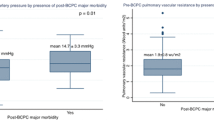Abstract
The parallel supply of the pulmonary and systemic circuits complicates the management of single-ventricle lesions. Achieving a balance between the two limbs of the circulation forms the basis of optimizing the systemic oxygen delivery, with the oxygen availability being highly sensitive to alterations in pulmonary/systemic blood flow ratio (Qp/Qs). The identification of a ‘balanced’ circulation is challenging wherein various parameters should be evaluated in close conjunction with each other. The prompt identification of circulatory maldistribution should be backed up with a sound management strategy aimed at attaining an equitable systemic and pulmonary perfusion. Any degree of ventricular dysfunction compromises the total output (Qp + Qs) supplying the two circuits explaining the role of inodilators in improving the myocardial performance in addition to lowering the systemic vascular resistance and optimizing Qp/Qs in setting of a single-ventricle physiology. Moreover, the pulmonary circulation is modulated by a multitude of factors intricately linked to the single-ventricle lesion, including anatomical characteristics unique to the underlying lesion (branch pulmonary arterial and venous stenosis), preoperative interventions, associated aortopulmonary and venovenous collaterals, plastic bronchitis, pulmonary arteriovenous fistulae, underlying ventricular dysfunction,, and many others. The article highlights the physiology, diagnosis, therapeutic optimization of a single-ventricle circulation, and the peculiarities pertaining to the pulmonary circulation of the uni-ventricular lesions.

Similar content being viewed by others
References
Barnea O, Santamore WP, Rossi A, Salloum E, Chien S, Austin EH. Estimation of oxygen delivery in newborns with univentricular circulation. Circulation. 1998;98:1407–13.
Murdison KA, Baffa JM, Farrell PE Jr, et al. Hypoplastic left heart syndrome. Outcome after initial reconstruction and before modified Fontan procedure. Circulation. 1990;82:IV199–207.
Hauck A, Porta N, Lestrud S, Berger S. The pulmonary circulation in the single ventricle patient. Children (Basel). 2017;4. https://doi.org/10.3390/children4080071.
Rossi AF, Sommer RJ, Lotvin A, et al. Usefulness of intermittent monitoring of mixed venous oxygen saturation after stage I palliation for hypoplastic left heart syndrome. Am J Cardiol. 1994;73:1118–23.
Riordan CJ, Locher JP Jr, Santamore WP, Villafane J, Austin EH 3rd. Monitoring systemic venous oxygen saturations in the hypoplastic left heart syndrome. Ann Thorac Surg. 1997;63:835–7.
Taeed R, Schwartz SM, Pearl JM, et al. Unrecognized pulmonary venous desaturation early after Norwood palliation confounds Gp: Gs assessment and compromises oxygen delivery. Circulation. 2001;103:2699–704.
Riordan CJ, Randsbeck F, Storey JH, Montgomery WD, Santamore WP, Austin EH 3rd. Effects of oxygen, positive end-expiratory pressure, and carbon dioxide on oxygen delivery in an animal model of the univentricular heart. J Thorac Cardiovasc Surg. 1996;112:644–54.
Tweddell JS, Hoffman GM, Fedderly RT, et al. Phenoxybenzamine improves systemic oxygen delivery after Norwood procedure. Ann Thorac Surg. 1999;67:161–8.
Gewillig M, Goldberg DJ. Failure of the fontan circulation. Heart Fail Clin. 2014;10:105–16.
Gewillig M, Brown SC, Heying R, et al. Volume load paradox while preparing for the fontan: Not too much for the ventricle, not too little for the lungs. Interact Cardiovasc Thorac Surg. 2010;10:262–5.
Henaine R, Vergnat M, Bacha EA, et al. Effects of lack of pulsatility on pulmonary endothelial function in the fontan circulation. J Thorac Cardiovasc Surg. 2013;146:522–9.
Khambadkone S, Li J, de Leval MR, Cullen S, Deanfield JE, Redington AN. Basal pulmonary vascular resistance and nitric oxide responsiveness late after fontan-type operation. Circulation. 2003;107:3204–8.
Snarr BS, Paridon SM, Rychik J, Goldberg DJ. Pulmonary vasodilator therapy in the failing fontan circulation: rationale and efficacy. Cardiol Young. 2015;25:1489–92.
Funding
We declare that no funding is involved in repoting of this article.
Author information
Authors and Affiliations
Corresponding author
Ethics declarations
Ethical statement, informed consent, and human and animal rights statement
Not applicable.
Conflict of interest
The authors declare that they have no conflict of interest.
Additional information
Publisher’s note
Springer Nature remains neutral with regard to jurisdictional claims in published maps and institutional affiliations.
Rights and permissions
About this article
Cite this article
Magoon, R., Makhija, N. & Jangid, S.K. Balancing a single-ventricle circulation: ‘physiology to therapy’. Indian J Thorac Cardiovasc Surg 36, 159–162 (2020). https://doi.org/10.1007/s12055-019-00889-w
Received:
Revised:
Accepted:
Published:
Issue Date:
DOI: https://doi.org/10.1007/s12055-019-00889-w



